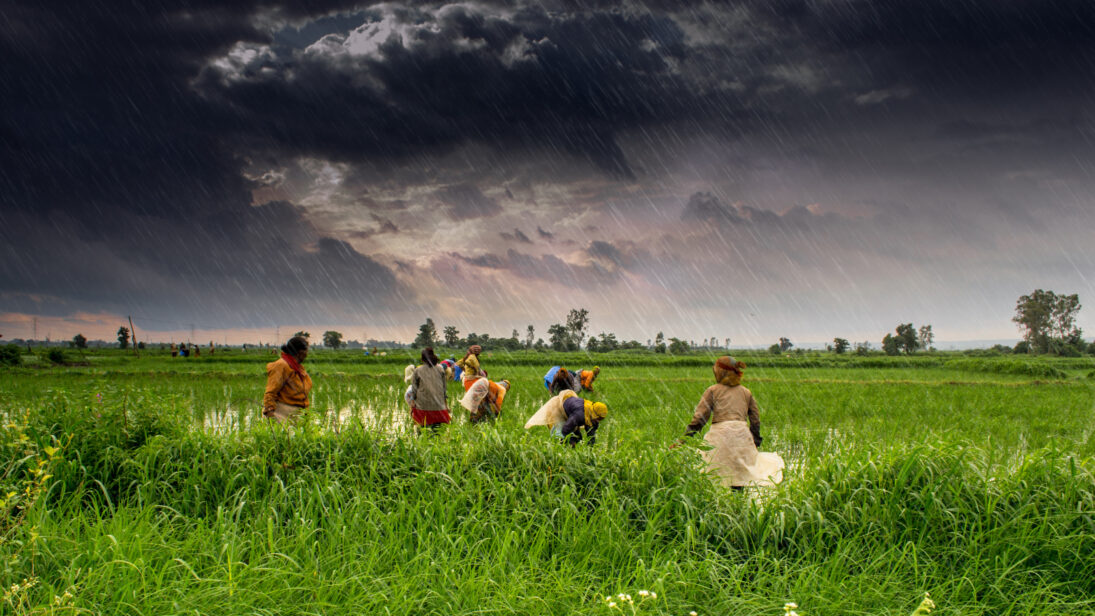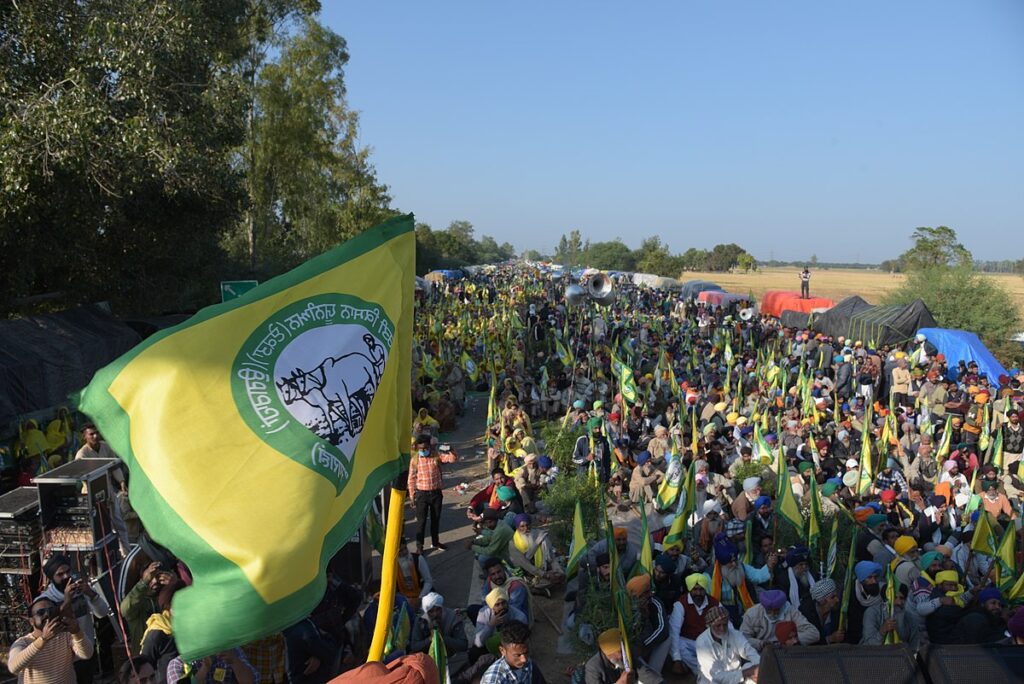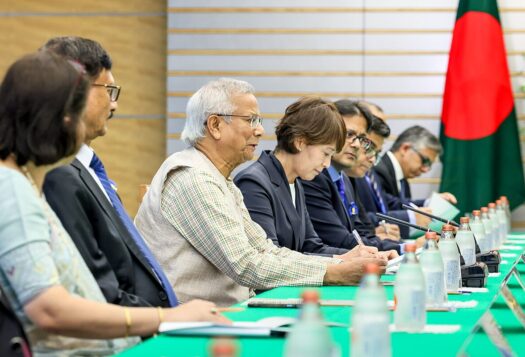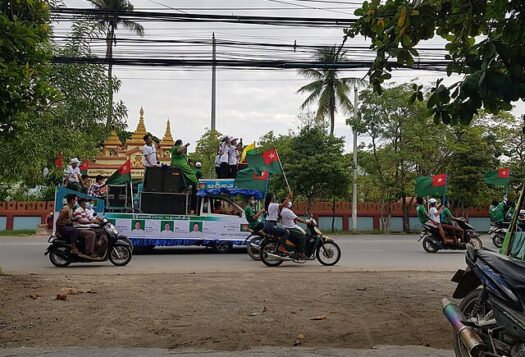
After a month-long chase and a nationalist media frenzy, Amritpal Singh Sandhu, a 29-year-old pro-Khalistan preacher and leader of Waris Punjab De, surrendered to police forces on April 23 in the north-western Indian border state of Punjab. 353 Sikh youth were arrested, out of which only ten had cases on them, the internet was blocked across the state, a state-wide cordon and search exercise was conducted, 1,900 Central Reserve Police Force security personnel and an anti-riot Rapid Action Force were dispatched, and even Nepal was requested to put Singh on its surveillance list. This was in addition to the fact that Border Security Forces are deployed within 50 kilometers of the international border, resulting in almost half of Punjab being under heightened state surveillance. Meanwhile, corporate media was flooded with allegations of Singh’s links with Pakistan’s ISI, and the BJP was lauded for his ultimate arrest.
Singh revived calls from the 1980s for ‘Khalistan’, a sovereign Sikh state in the northwestern regions of India and from the Indian state’s perspective, a dire national security threat. While the Khalistan movement does not have mainstream support in Punjab, a sect of Punjabi youth looked to Singh as a source of hope and leadership amidst decades of discontent in Punjab surrounding unemployment, environmental degradation, corporate farm laws, drug use, and a lack of basic welfare delivery in the state. Both in the 1980s and today, New Delhi has taken a security-first approach in Punjab, often using force to address the state’s long-standing economic and environmental issues.
One month later, the news cycle has swiftly moved on but the root causes of tensions in Punjab remain largely ignored by New Delhi. Instead of securitizing the Punjab issue and creating national alarm, New Delhi should view the Amritpal Singh episode as a wake-up call to address the long-standing economic and environmental issues in the state.
Both in the 1980s and today, New Delhi has taken a security-first approach in Punjab, often using force to address the state’s long-standing economic and environmental issues.
Environment and Economy: the Roots of Discontent
While Punjab’s challenges are a combination of economic hardship, ecological degradation, unemployment, drug use, and political failure, several scholars have traced Punjab’s myriad social and economic issues to the failures of the Green Revolution. While this corporate experiment launched in 1968 did lead to short-term positive results for India’s food basket, the long-term environmental and economic failures have resulted in several social and political conflicts in the state. Each protest, demonstration, and march has been met with a securitized state response.
A key cause of agitation in Punjab has been its water crisis. Even before the Green Revolution in the mid-1960s, thousands of peasant farmers organized a peaceful agitation against the high prices of irrigated water imposed by the state. When the Congress’s attempts to appease protestors through concessions failed, instead of working towards a negotiated solution, armed police forces were sent into the agitations to lathi charge, arrest, tear gas, and loot non-combatant protestors. The Green Revolution, coupled with climate change, has worsened Punjab’s water crisis and such ongoing civil agitations. Due to the ‘high-yielding varieties’ of seeds requiring three times the amount of irrigated water than traditional seeds, Punjab’s groundwater table is decreasing by nearly 0.49 meters per year. Anxieties over water scarcity have manifested in both small and large-scale social and political tensions – from local farmers union protests over the concretization of canals to the Sutlej-Yamuna Link Canal dispute between the states of Punjab and Haryana.
The technology of the Green Revolution required large amounts of input and led to lower incomes for small farmers, and peasants continue to suffer as the cost of input outweighed the output cost. Again, between 1983 and 1984 during the height of militancy in Punjab, farmers led by the Bharatiya Kisan Union, conducted a 14-month-long peaceful agitation demanding the central government to keep input prices low as income began to slow as an outcome of the Green Revolution. When the state did not move on this demand, the agitation ended with a call by the Shiromani Akali Dal (the regional party in power at the time) and the leading farmers’ union to stop grain movement outside Punjab. Two weeks later, paramilitary forces attacked the holy Sikh site, the Darbar Sahib Complex, in Operation Blue Star, resulting in years of anti-Sikh communal and state violence. While Operation Blue Star was formally the military operation to capture radical Sikh leader Jarnail Singh Bhindrawale, several Punjabi farmers’ unions believe that it was the economic threat posed by the farmers’ movement rather than the sporadic Khalistan threats that ultimately prompted Indira Gandhi’s government to take such drastic military measures.

The last two decades have witnessed a suicide epidemic among farmers in Punjab, 88 percent of which were driven by debt due to loans for seeds, fertilizers, and pesticides. Adding to Punjab’s rich history of peasant revolts, 500,000 Sikh farmers marched to New Delhi between 2020 and 2021 to protest the BJP government’s attempt to pass three controversial farm laws which would have led to the further corporatization of agriculture in the state. Before the BJP ultimately repealed the laws, state and media propaganda again attempted to brand these non-violent protests – characterized by music, poetry, and the Sikh tradition of langar (free distribution of food) – as a national security threat to delegitimize the farmers’ demands. Right-wing news media hawked on about the farmers’ attempt to send India back to the dark ages of militancy in the 1980s by ‘stoking Sikh separatist sentiments’, while BJP leaders called the farmers ‘terrorists,’ ‘Naxals,’ and ‘Khalistanis’. Meanwhile, the movement’s leaders were arrested and the internet was repeatedly shut down, two common moves often utilized by non-democratic governments.
The Branding of National Security
Both historically and today, the Indian government has deployed a common tactic – it has framed issues that are fundamentally political economy issues through the lens of national security. By using discursive means to transform ordinary political issues into security issues, the state convinces the public of an existential threat which then justifies their extraordinary responses, such as declaring states of emergency or deploying paramilitary forces into civilian disputes.
It is the state’s paranoia that views non-violent civic agitations as threats to national security and sovereignty. In 2023, by emphasizing the fringe demand for ‘Khalistan’ – the most extreme and marginal articulation of social, political, and economic discontent in the state – corporate media and the BJP have securitized the issue and manufactured national alarm to ultimately curb dissent. Notably, with the backdrop of India’s many real external security threats from China and Pakistan, branding issues as ‘national security issues’ justifies the state’s militarized responses to political, economic, and environmental agitation. When a development issue is securitized, the targets of the state response are often vulnerable populations, and in India, this securitization has historically occurred along ethnic and religious lines. On the danger of securitizing the climate challenge for instance, Betsy Hartmann writes, “playing with fear is like playing with fire.”
It is the state’s paranoia that views non-violent civic agitations as threats to national security and sovereignty.
It is well documented that environmental and economic issues can exacerbate preexisting social and political tensions, and in some cases, even lead to violent conflict. This ‘environmental security’ paradigm, which is propounded by several researchers and argues that environmental issues will ultimately lead to security crises, is evident in Punjab, where decades of bad agrarian policy have led to environmental crises in the state, and coupled with government neglect, have now resulted in anger, discontent, and a few toothless demands for secession. However, the dangers of emphasizing the nexus between environmental, economic, and security issues is that the public fear that arises from perceived security threats enables governments to address the ‘security’ axis without addressing the environmental and economic ones.
“Khalistan is nothing but a metaphor for a dejected people wanting human rights. We need to reconfigure how we speak about Khalistan to talk about justice for Punjab.”
-Author interview with Amandeep Sandhu, journalist and author of Panjab: Journey through the Fault Lines
The Congress in 1958 and 1984 and the BJP in 2021 and today have pulled from the same playbook. By securitizing political economy issues, successive central governments have diverted blame away from failed economic policy –towards Muslims, Maoists, Sikhs, and ‘Khalistanis’ – resulting in the absence of meaningful economic and environmental reform. What is needed is a narrative shift away from security solutions and towards political economy solutions in Punjab. New Delhi should pivot from needless manhunts and militarization to agricultural, land, and canal reform, natural farming techniques, minimum support price (MSP) for farmers, and small and medium-scale industry development to boost employment in the state. Privileging a political economy approach to policy-making in Punjab over a security-first approach will prevent fault lines in the state from being exploited by addressing the root causes of discontent.
This article was originally published in The Diplomat.
Also Read: The Impact of Russia’s War in Ukraine on India’s Food Insecurity
***
Image 1: Rural farms in India via Wikimedia Commons
Image 2: 2021 Farmers Protests via Wikimedia Commons


